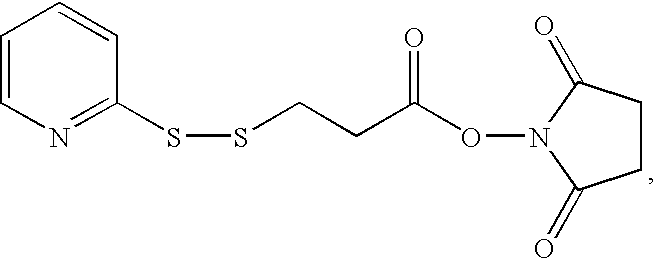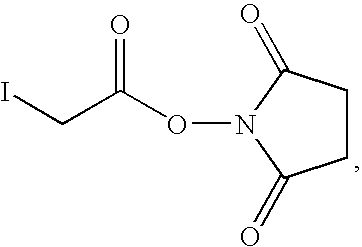Cytoplasmic Localization Dna and Rna
- Summary
- Abstract
- Description
- Claims
- Application Information
AI Technical Summary
Benefits of technology
Problems solved by technology
Method used
Image
Examples
example 1
[0070]An automatic DNA synthesizer (manufactured by Cruachem, product name: “PS250”) was used to chemically modify the 5′-terminus of an oligonucleotide HIV-1 Rev (5′-SEQ ID NO: 16 in Sequence Listing-3′) with an O-aminoethoxyethyl-O′-cyanoethylphosphoric ester residue on a CPG support according to a routine method.
[0071]Subsequently, the oligonucleotide was supplemented and reacted at 20° C. for 5 hours with 0.5 M solution prepared by dissolving hexamethylene diisocyanate in acetonitrile and then reacted with a peptide fragment HIV-1 Rev (SEQ ID NO: 1 in Sequence Listing) having a free N-terminal amino group with the protected amino acid side chain, thereby binding the NES peptide to the 5′-terminus of the oligonucleotide via the hexamethylene diisocyanate.
[0072]Next, this reaction product was supplemented with ammonia water with a concentration of 28% and stirred at 55° C. for 5 hours, thereby cleaving the produced conjugate from the solid support and removing the protecting group...
example 2
[0077]A DNA localized in the cytoplasm represented by the formula 5′-SEQ ID NO: 17 in Sequence Listing-3′-PO(OH)—O—CH2CH2OCH2CH2—NH—CO-SEQ ID NO: 1 in Sequence listing, wherein the first Ala in SEQ ID NO: 1 in Sequence Listing is β-alanine, was obtained at a yield of 2.7% in the same way as in Example 1 except that 5′-SEQ ID NO: 17 in Sequence Listing-3′ was used as a DNA to introduce the NES peptide (SEQ ID NO: 1 in Sequence Listing) via a residue as a linker represented by the formula
The enzymatic degradation resistance thereof was 29.1%, the degradation property in serum was 42.3%, and the telomerase inhibition activity in a system using a cell lysis solution was 120 nM. In a cell system, approximately 12% telomerase activity inhibition was confirmed.
[0078]The observed telomerase inhibition activity of the raw material DNA used as a control was 400 nM or higher in a non-cell system and 0% in a cell system.
[0079]Next, this DNA localized in the cytoplasm was fluorescently labeled i...
example 3
[0080]A DNA localized in the cytoplasm represented by the formula 5′-SEQ ID NO: 18 in Sequence Listing-3′-PO(OH)—O—CH2CH2OCH2CH2—NH—CO-SEQ ID NO: 3 in Sequence listing, wherein the first Ala in SEQ ID NO: 1 in Sequence Listing is β-alanine, was obtained in the same way as in Example 2 except that 5′-SEQ ID NO: 18 in Sequence Listing-3′ and MAPKK (SEQ ID NO: 3 in Sequence Listing) were used as a DNA and an NES peptide, respectively.
[0081]The enzymatic degradation resistance thereof was 34.2%, the degradation resistance in serum was 41.4%, and tyrosine kinase activity inhibition was approximately 46.2%. The enzymatic degradation resistance of the raw material DNA used as a control was 49.2%, the degradation resistance in serum thereof was 56.9%, and the tyrosine kinase activity inhibition thereof was approximately 21.8%.
[0082]Next, this DNA localized in the cytoplasm was fluorescently labeled in the same way as in Example 1 and examined for its cytoplasmic localization. For comparison...
PUM
| Property | Measurement | Unit |
|---|---|---|
| Fraction | aaaaa | aaaaa |
| Fraction | aaaaa | aaaaa |
| Fraction | aaaaa | aaaaa |
Abstract
Description
Claims
Application Information
 Login to View More
Login to View More - Generate Ideas
- Intellectual Property
- Life Sciences
- Materials
- Tech Scout
- Unparalleled Data Quality
- Higher Quality Content
- 60% Fewer Hallucinations
Browse by: Latest US Patents, China's latest patents, Technical Efficacy Thesaurus, Application Domain, Technology Topic, Popular Technical Reports.
© 2025 PatSnap. All rights reserved.Legal|Privacy policy|Modern Slavery Act Transparency Statement|Sitemap|About US| Contact US: help@patsnap.com



